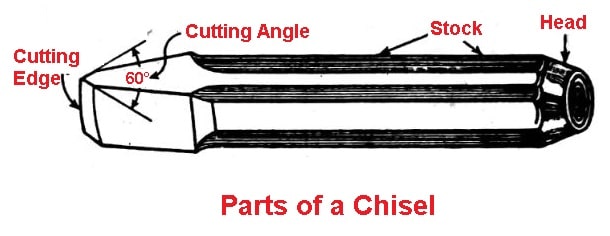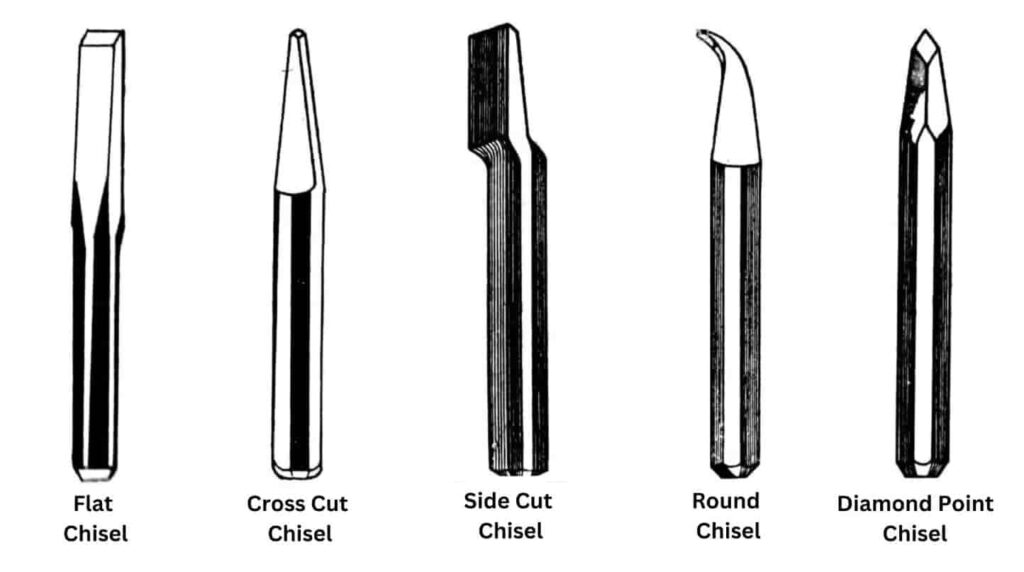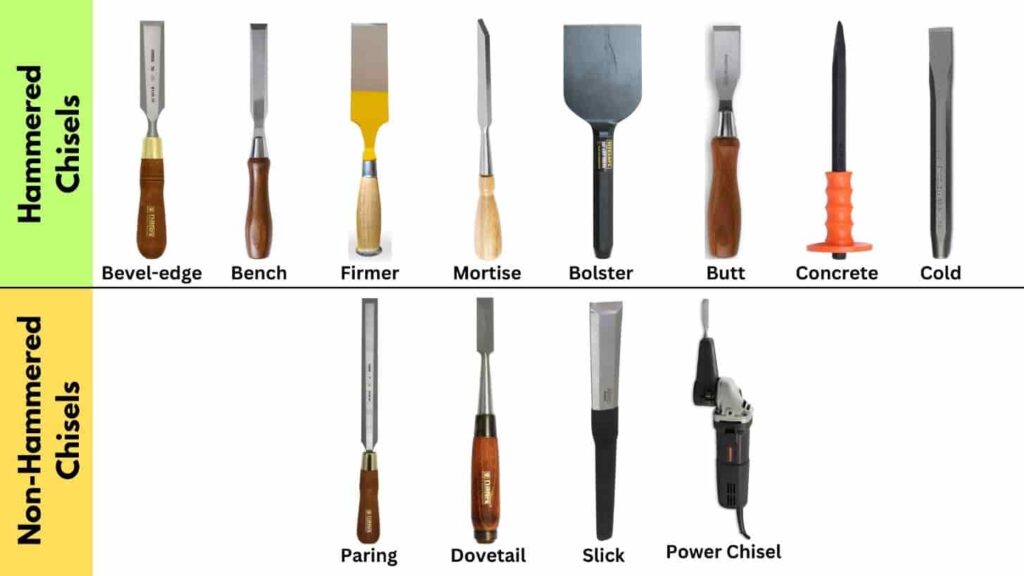In this article, you’ll learn what is a chisel and How it is used in the workshop. with its Parts, Methods, Precautions, and Types of Chisel.
Chisel and Its Types
A chisel is used to cut flat, round, or angle iron and thick metal sheets. It is also used to remove unwanted metal from the surface of a job by cutting it into bits and small pieces. This act is known as chipping.
The cutting done by a chisel is rough. Therefore, there is a need for finishing after chipping done by the chisel. It saves time. Chisels are used both on hot and cold metals. As such chisels have been divided into two categories.
Classifications of Chisel
- Hot chisel
- Cold Chisel
#1 Hot Chisel
A hot chisel is used for cutting hot metals in a blacksmith’s workshop. There is a hole in a chisel in which a wooden handle is fixed. Their cutting edge is made at an angle of 30°. While using this part, it is frequently dipped into water to make it cold so that its edges remain intact.
#2 Cold Chisel
Cold chisels are generally used in sheet metal and fitter trade workshops. With a cold chisel cutting or chipping of metal can be done when these metals are in cold conditions.
This is available in 4 sides, 6 sides, or 8 sides. These are made of high-carbon steel, which contains 0.75% to 1.00% of carbon. Generally, a chisel, of 150 mm length is used. Practically, chisel measurement is known from the width of the chisel cutting edge.
Read Also: 9 Different Types of Sheet Metal Operations
Parts of a Chisel
The following are the different parts of a chisel:
- Head
- Body
- Forging angle
- Cutting edge
- Cutting angle

#1 Head
The topmost part of a chisel is called the “Head”. It is a bit suck in the middle so that the blow of the hammer strikes at the center of the chisel. Thus, because of repeated blows, its head becomes a mushroom as shown in Fig.
In this case, the chisel’s head should be set right by grinding. While making the head, the upper part of the body should be 10° to 20°.
#2 Body
That part of a chisel from which we hold it is called the body or stock. It is made of four, six, or eight sides so that it is easy to hold. The body is made somewhat flat from the bottom.
#3 Forging Angle
Some part of the flat position below a chisel body is tapered. This angle of taper is called the forging angle. It is also known as Draw Angle.
#4 Cutting Edge
That part of the chisel that performs the function of cutting is called the cutting edge. Its width is taken as a chisel measurement.
#5 Cutting Angle
The angle at which the cutting edge of the chisel is grinded is known as its cutting angle. For cutting hard metal, the cutting angle is more and for cutting soft metals the cutting angle is less. While grinding chisels for cutting various kinds of metals their angles should be as under:
- Mild steel – 55 °
- Cast iron – 60 °
- Tool steel – 65 ° to 70 °
- Copper – 45 °
- Aluminum – 30 °
- Brass – 50 °
Hardening and Tempering of Chisel
To make the cutting edge last longer even the tapered part of a chisel is made hard and the edge is tempered. For this purpose, the chisel should be heated at an appropriate temperature up to half of its length and this edge part of the chisel should be cooled in clean water.
This would make that particular part of the chisel hard. Then its edge part should be cleaned with a sand-paper. Again it should be heated at an appropriate temperature.
Now the color of this part would start changing and when it turns into the appropriate color, it should be cooled down in lime-water. This would temper the longer period.
Read Also: The Concept of Rolling Mills with Types of Rolling Mills
Types of Chisel
Following are the different types of chisel:
- Flat chisel
- Crosscut chisel
- Side cut chisel
- Round Nose Chisel
- Diamond point chisel
- Cow mouth chisel

#1 Flat Chisel
In these types of chisel, It is an all-metal chisel used for obtaining a flat surface on metal by chipping. This chisel is used to cut wires, thin sheets round rods, etc.
The edge of this chisel is in a “V” shape and is flat, which is raised from the center. Because of these projected parts, it does not get stuck into the cut surface, while chipping.
#2 Cross Cut Chisel
It is mainly used to cut square slots and channels. The keyway on a shaft is made with this chisel. Its cutting edge is from 3 mm to 12 mm in width.
In order to ensure that this chisel does not get stuck into the grooves and slits while using it in the grooves and slits, the part behind its edge is made comparatively thin.
#3 Side Cut Chisel
Where other types of chisel cannot be used easily, side-cut chisels are used. The keyway and cotterway are cleaned with this chisel.
It is almost similar to the flat chisel but the part which performs the function of cutting is turned to one side. It is turned at an angle and then forged. Its cutting angle is generally at and forging angle at an angle.
#4 Round Nose Chisel
Its edge is round. It is used for making an oil groove in a bearing and for cutting slits at corners. Its forging angle is at and cutting angle of 35 ° to 40 °. In such jobs where the drill is dislocated at the time of drilling and some substance is left, the leftover metal is set right with this chisel.
#5 Diamond Point Chisel
This is made of good quality steel. Its shape is square and it is tapered. Its edge is pointed and of the shape of a diamond.
On the basis of its square ends, its measurement is determined. Square corners and triangle corners are cleaned with it. We can make a groove on a plain surface with this chisel.
#6 Cow Mouth Chisel
In these types of chisel, Its shape is like that of the broad mouth of a cow. That is why it is known as cow mouth chisel. Edges of the protruding parts of plain metal and rivet heads and big round holes are made with it. Its forging angle is at an angle.
Types of Chisels
They can be distinguished into two categories based on how they are used: those that require hammering and those that don’t.

Hammered Chisels
These types of chisels usually work with a hammer. Hammering chisels often have stronger and harder blades to resist greater power. The flat head of these chisel handles is intended to be hammered by a hammer.
The many types of chisels that require hammering when working on metal, wood, or stone, as well as their applications, are explained below.
#1 Bevel-edged Chisel
It’s a strong chisel that’s not too long or too short. This chisel consists of a beveled or angled side and a straight edge. It is simpler to reach corners and dovetail joints because of the straight and beveled edges.
#2 Bench Chisel
Bench chisels are robust tools with a tang or socket that are shorter than bevel-edge chisels. When struck with a hammer, the top hoop of this chisel allows the maximum amount of energy to reach the cutting edge. They are perfect for joinery, paring, cutting, and trimming when working on furniture.
#3 Firmer Chisel
Firmer chisels are considered to be the oldest types. This chisel is made of steel or other hard materials and is meant for heavy-duty tasks. Their blade has a 20-degree bevel and a rectangular cross-section.
They are perfect for making extremely sharp 90-degree corners because of their form. These types of chisel have hardwood or hardened plastic handles to withstand the strikes of a hammer or mallet.
#4 Mortise Chisel
To cut deep mortise joints, use a mortise chisel. The thicker blade of this chisel is heavier than its width. The blade has massive forged bolsters to avoid bending while hammering.
A mortise chisel’s handle is made of hardwood, capped, or steel hoops. It can bear pressure and several hard blows. Usually, the head of the chisel is cut at an angle of 30 to 40°. They are perfect for pulling out waste woodwork and cutting off joints.
#5 Bolster Chisel
A bolster chisel, often called a brick chisel, is used to make straight cuts in materials including stones, metal, and bricks. It has a sharp beveled edge blade with a flat handle that can cut through most hard materials with a single blow from a hammer.
#6 Butt Chisel
The blade of a butt chisel is particularly short. It is a modified version of bench chisels or stronger chisels. This chisel has cutting edges that are straight and beveled. They are used for construction applications such as inserting hinges and butts.
#7 Concrete Chisel
A concrete chisel is a tool used to break up concrete floors, sidewalks, and paving slabs. It has a big striking area as well as a head design that minimizes mushrooming.
#8 Cold Chisel
Cold chisels cut and shape hard materials like cold metal, whereas other tools like hacksaws, shears, and tin snips are not appropriate. The term cold refers to the fact that the metal is not warmed before utilizing the tool.
These are often made of tempered carbon tool steel, which makes them tough enough to pierce metal and stone. Cold chisels come in a variety of shapes and sizes, including flat, cape, round-nose, and diamond-pointed chisels.
Non-hammered Chisels
A tang chisel is the most popular chisel that does not require hammering. They are divided into the following categories.
#1 Paring Chisel
Paring chisels have a slender blade with a bevel grind at 15 degrees and a light, thin cutting edge. Compared to tougher chisels, the blades are often longer and have a different handle design. A paring chisel is not meant to be struck with a hammer or mallet because it is meant for light work.
#2 Dovetail Chisel
Dovetail chisels are used to finish joins and make dovetails. They have a long blade and a cutting edge that is 20–30° beveled. They are perfect for wiping out and honing joints because of their length.
#3 Slick Chisel
Slick chisels have wider, straighter blades and function nearly identically to paring chisels. The handle is shaped like a baseball bat to make it comfortable to hold when paring thin slices of wood.
#4 Power Chisel
The power chisel is driven by an electrical grinder motor, which also performs hammer functions. Compared to other traditional hand-held chisels, these are both faster and more effective.
Methods of Using Chisel
A chisel is used for cutting and chipping a thin metal sheet, plate, round rod, and other material. In Fig cutting of a metal plate has been illustrated. The following points should be kept in mind while using a chisel:
- Accurate marking should be done on the metal to be cut.
- Always hold the chisel properly with your left hand and the hammer in your right hand.
- Set the chisel properly on the marked line then strike the hammer on its head. Before striking the second blow on the chisel, it should be set again.
- While cutting with a chisel we should concentrate on its cutting edge.
- Strike the hammer blow at the center of the head of the chisel.
Precautions for Using a Chisel
- At the time of chipping, we must always use safety goggles.
- Keep your face towards the wall, while chipping.
- If someone is working in your front, you should fix the chipping guard at the rear of the vice so that the chips do not hit him.
- The mushroom head chisel should never be used for chipping.
- There should not be any greasy substance on the chisel head and face of the hammer being used for chipping.
- An extraordinarily long chisel should not be used for chipping.
- While chipping we should keep on applying grease on the edge of the chisel.
That’s it, thanks for reading. If you have any questions about “Types of Chisel” you can ask in the comments.
Subscribe to our newsletter. It’s FREE!
Download the PDF file of this article from here:
Read Next:
good resource, thanks
You’re welcome.
It is soo use full for us it is good knowledge for us to read and improve our skill..
Thanks 🙂